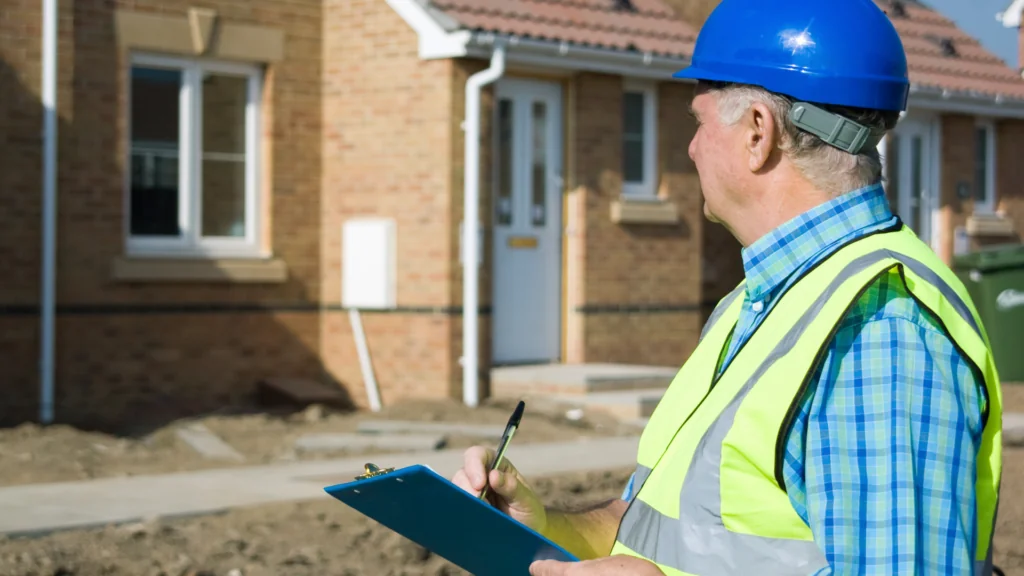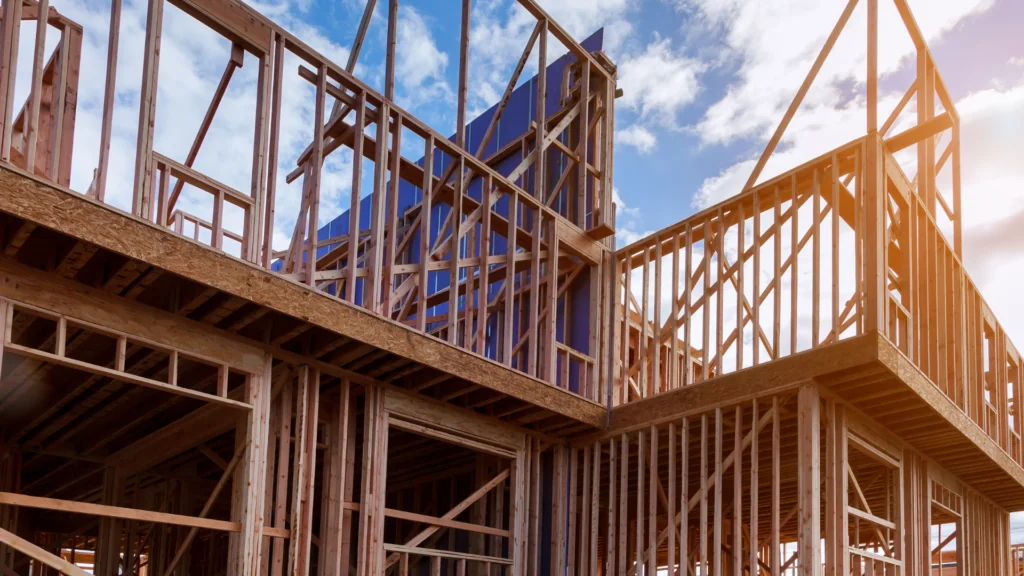- What Is a Prefab House?
- What Are the Different Types of Prefab Houses?
- Pros and Cons of Owning a Prefab Home
- Can You Get a Mortgage on a Prefab House in the UK?
- Eligibility Criteria for a Prefab Mortgage
- How to Make a Prefab House Mortgageable
- Which Type of Mortgage Is Right for Prefab Homes?
- How Much Can You Borrow for a Prefab House?
- The Role of Mortgage Brokers When Buying a Prefab House
- Do Prefab Homes in the UK Hold Their Value?
- Tips for Buying a Prefab House in the UK
- Key Takeaways
- The Bottom Line
Can You Get a Mortgage on a Prefab House? A UK Buyer’s Guide

Prefab homes have come a long way since their post-war days.
They’re no longer just quick-fix housing but are now modern, stylish, and often eco-friendly.
But here’s the thing: getting a mortgage for a prefab isn’t quite as simple as for a classic brick-and-mortar home.
It’s doable, though, so don’t worry.
In this guide, we’ve covered how you can secure a mortgage for a prefab home in the UK and help you decide if it’s the right choice for you.
What Is a Prefab House?
A prefab house is a home built in a factory and then transported to your plot for assembly. These homes were first popular after WWII as a quick solution to housing shortages, but they have come a long way since then.
Prefab homes, or prefabricated houses, were indeed popular after the war as a quick solution to the housing shortage. But times have changed, and so have prefab homes.
Today’s prefab houses come in various shapes, sizes, and materials.
From energy-efficient kit homes to stylish modular builds, these homes are built off-site (like Lego pieces), then transported and assembled on your plot.
With their quick construction and eco-friendly features, they’re gaining more popularity.
What Are the Different Types of Prefab Houses?
There are several types of prefab homes available in the UK, each with its unique features and benefits:
- Modular Home. These are built in sections (or modules) in a factory, transported to the site, and assembled on a permanent foundation. Modular homes are usually more customisable and can be built to high standards.
- Manufactured Home. Also known as mobile homes, these are built in large sections and assembled on-site. Unlike modular homes, they aren’t built on a permanent foundation, which can make financing trickier.
- Kit Home. These homes come in parts, like a giant DIY project, and can be assembled by private contractors or even by the homeowner. Kit homes are often popular for their affordability and customization options.
Pros and Cons of Owning a Prefab Home
Owning a prefab home comes with its fair share of perks and challenges. Here’s a look at both sides of the coin:
Pros
- Eco-Friendly. Prefabs often have superior insulation, which means better energy efficiency and lower utility bills. They also tend to have tighter construction, which helps maintain indoor temperatures.
- Cost-Effective. Prefabricated homes are generally cheaper than traditional brick-and-mortar homes. The speed of construction means fewer labour costs and less risk of cost overruns.
- Speed of Construction. Prefabs are built off-site and can be assembled in a matter of days once they arrive, which means you can move in much faster.
- Customisation. Many prefab homes offer a wide range of designs and customisation options, giving you more flexibility to create your ideal living space.
- Less Waste. Building in a factory setting reduces material waste, making the process more efficient and environmentally friendly.
Cons
- Utilities and Infrastructure. If your site is remote, connecting utilities like electricity, water, and sewage can be a challenge and add to your costs.
- Red Tape. You’ll need to deal with zoning laws, building codes, and permits, which can be time-consuming and sometimes costly.
- Upfront Costs. Prefabs often need to be paid for upfront, which can be more financially demanding compared to traditional homes where you pay over time.
- Design Limitations. While modern prefabs are customizable, they may lack some of the unique character details you get with traditional homes.
Can You Get a Mortgage on a Prefab House in the UK?
The short answer is yes—you can get a mortgage for a prefab house in the UK. But it’s not as straightforward as a standard mortgage.
Prefab houses are considered “non-standard construction” properties by lenders, which means that they don’t fit the traditional “brick-and-tile” box.
And as you might expect, anything out of the box tends to make mortgage lenders a bit nervous.
Non-standard construction properties often come with higher risks, like potential structural issues or difficulties in resale.
This is why lenders can be extra cautious—some even avoiding prefab mortgages altogether.
But fear not. There are lenders out there who do approve mortgages for modular homes, provided you tick a few extra boxes.
Eligibility Criteria for a Prefab Mortgage
Because prefab homes are considered non-standard, lenders tend to be more cautious, and you may need to meet specific criteria to secure a mortgage.
Here are some common requirements:
- Certification and Guarantees: Older prefabs, especially PRC homes, may need certifications like a PRC Completion Certificate to prove they are structurally sound and have been repaired to a safe standard.
- Larger Deposit: Prefab mortgages often require a higher deposit—typically between 25% to 50% of the property value.
- Affordability and Creditworthiness: As with any mortgage, your income, credit score, and overall financial health will be assessed to determine your eligibility.
How to Make a Prefab House Mortgageable
If you want to get a mortgage for a prefab home, here are some steps you can take:
- Get Certification. If it’s an older prefab, like a PRC (precast reinforced concrete) home, you need a PRC Completion Certificate to show that it has been reinforced and repaired to a safe standard. No certificate means no mortgage.
- Hire a Surveyor. A good surveyor who knows prefabs can be very helpful. They will do a building survey to check the quality of the property, which will reassure lenders that your home is safe.
- Highlight Energy Efficiency. Modern prefab homes are often energy efficient, which can help you qualify for a “green mortgage.” Lenders are more open to financing eco-friendly homes, so it’s worth highlighting any energy-saving features.
- Choose the Right Location. Buying in an area where prefab homes are common can improve your chances of getting a mortgage. Lenders like to see a market for resale, so if there are more prefabs around, they will be more comfortable lending.
- Get BOPAS Certification. The Buildoffsite Property Assurance Scheme (BOPAS) gives lenders confidence that your prefab is durable and can be sold for at least 60 years. This certification can make it easier to get a mortgage.
Which Type of Mortgage Is Right for Prefab Homes?
When it comes to prefabs, it’s not a one-size-fits-all situation. Different mortgages suit different situations, and it’s all about figuring out what works best for you.
- Standard Residential Mortgage. If your prefab meets certain standards (like having the right certifications and being built with modern methods), you may be able to get a regular residential mortgage.
- Green Mortgage. If your prefab is energy-efficient, you could be in luck. Green mortgages sometimes come with lower interest rates or incentives for being environmentally friendly.
- Self-Build Mortgage. Thinking of building your own prefab dream house? A self-build mortgage might be what you’re after. The loan is released in stages to help you fund the construction process—a great option if you want to be in control every step of the way.
- Bridging Loan. If you’re building from scratch and need a short-term loan to bridge the gap, a bridging loan could be an option. Just make sure you’ve got a plan for when it needs repaying—interest rates tend to be higher.
How Much Can You Borrow for a Prefab House?
It all depends on a couple of factors like your income, affordability, and the type of prefab.
Older prefab homes, particularly those without the right certification, could see a lower loan-to-value (LTV) ratio. This means you’ll need a bigger deposit (sometimes 25-50% of the property value).
For newer modular homes, especially those with energy-efficient features and certifications, lenders may be more generous.
Your best bet? Use a mortgage affordability calculator to get a quick estimate. Or better yet, speak to a mortgage broker who has experience with prefab properties.
They’ll help you crunch the numbers and figure out your options.
The Role of Mortgage Brokers When Buying a Prefab House
Speaking of brokers, let’s talk about why they’re so important when it comes to prefab homes.
Not every lender is going to be on board with a prefab. So finding the right one is half the battle.
This is where a specialist broker steps in. They’ve got access to the whole market and will know exactly which lenders are more comfortable with prefabs and what hoops you’ll need to jump through.
Good brokers can also help you with any necessary certifications, handle the paperwork, and ultimately make the whole process a lot less painful.
So, if you’re serious about buying a prefab, consulting with a broker is definitely worth considering.
Do Prefab Homes in the UK Hold Their Value?
Older prefabs have a bit of a reputation for losing value over time, and let’s be honest, not all of them have stood the test of time.
However, modern prefab homes are a different story.
These newer builds often come with better materials, higher energy efficiency, and more robust designs. And many can actually maintain or even increase their value if well-maintained.
The location, of course, plays a big part in all of this.
Buying in a desirable area will always help when it comes to resale value, prefab or not.
Tips for Buying a Prefab House in the UK
If you’re set on a prefab and ready to make a move, here are some tips to help you along the way:
- Check Your Certifications. Make sure any older prefab has the necessary PRC Completion Certificate or any other certifications required.
- Go Green. If your prefab is energy-efficient, mention it when applying for a mortgage. Green credentials can go a long way.
- Find a Specialist Lender. Not all lenders are prefab-friendly, so it’s worth seeking out those who are. A broker can help with this.
- Survey Time. Get a surveyor who knows their way around prefabs. It’ll save you headaches down the line and help you get that mortgage approved.
Key Takeaways
- Prefab homes are factory-built, assembled on-site, and offer quick, eco-friendly options.
- Types include modular (built in sections on permanent foundations), manufactured (mobile homes with limited financing), and kit homes (affordable DIY options).
- Prefabs are generally cost-effective, energy-efficient, and waste-reducing but can face challenges like utility setup, red tape, upfront costs, and limited design options.
- Mortgages for prefabs require higher deposits, certifications, and sometimes specialised lenders.
- Loan options include residential mortgages, green mortgages for eco-friendly models, self-build loans for custom projects, and bridging loans for short-term funding.
- To improve mortgage chances, ensure necessary certifications, highlight energy-saving features, use a specialist lender, and have a surveyor familiar with prefab homes.
The Bottom Line
Getting a mortgage for a prefab house in the UK is possible, but it takes more effort compared to a traditional brick home.
From getting the right certifications to finding a lender who understands prefabs, there are a few hoops to jump through.
But if you like the idea of an energy-efficient, customisable, and quickly built home, it’s worth it.
Get in touch with us, and we’ll match you with a good mortgage broker who’ll help you find the best deal, handle the paperwork, and answer any questions about financing your prefab home.
Get Matched With Your Dream Mortgage Advisor...

Frequently asked questions
Can I get a mortgage for an older prefab house?
Yes, but you need the right certifications, like a PRC Completion Certificate, to show that it is safe and durable.
Are modern prefab houses easier to finance?
Yes. Modern prefab homes use better materials and meet current building regulations, which makes them more appealing to lenders.
Will my prefab house lose value over time?
Older prefabs might lose value, but modern ones with quality materials and energy-efficient features can hold or increase their value, especially in a good location.
Is it worth getting a broker for a prefab mortgage?
Yes. Prefab mortgages are specialised, and a broker can help you find the right lender and handle the paperwork.
Can I put a prefab home anywhere in the UK?
You can put a prefab home on any plot you own, but you will need planning permission from your local council. Some areas may have restrictions on the types of homes allowed, so check with the council first.
How much does a prefab house cost in the UK?
The cost of a prefab house in the UK depends on its size, design, and materials. On average, prices range from £100,000 to £250,000, but custom features can increase the cost.
Can you get a mortgage on a park home in the UK?
No, you cannot get a standard mortgage for a park home in the UK. Park homes are not considered permanent structures and do not have a title with the Land Registry. This makes them ineligible for traditional mortgages. Instead, you may need specialist finance options for park homes.




